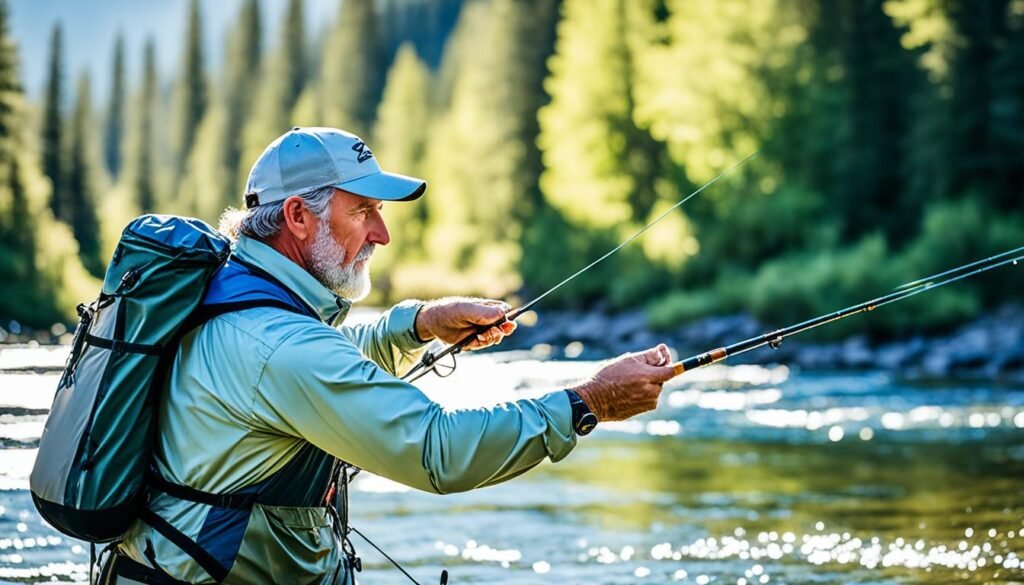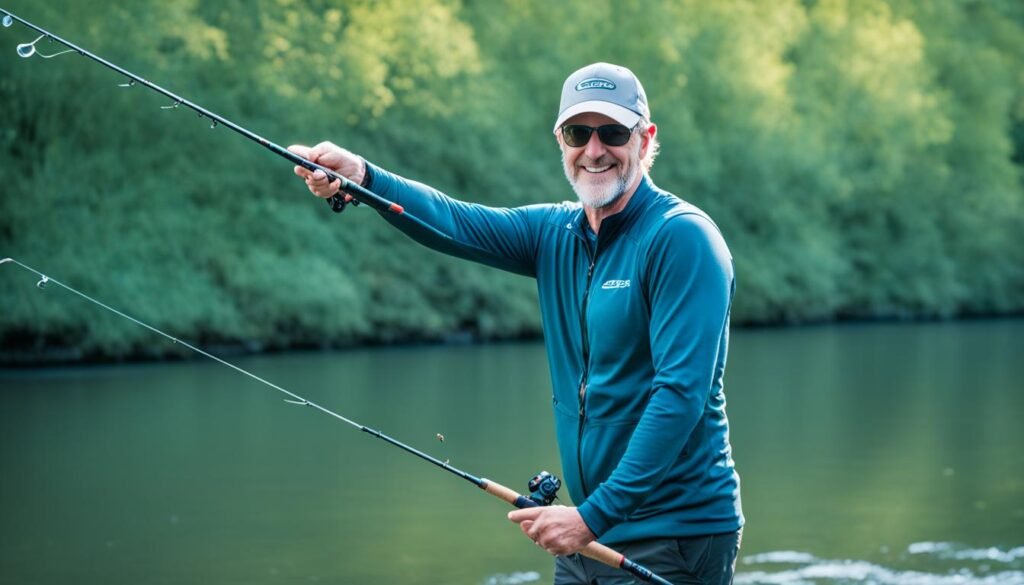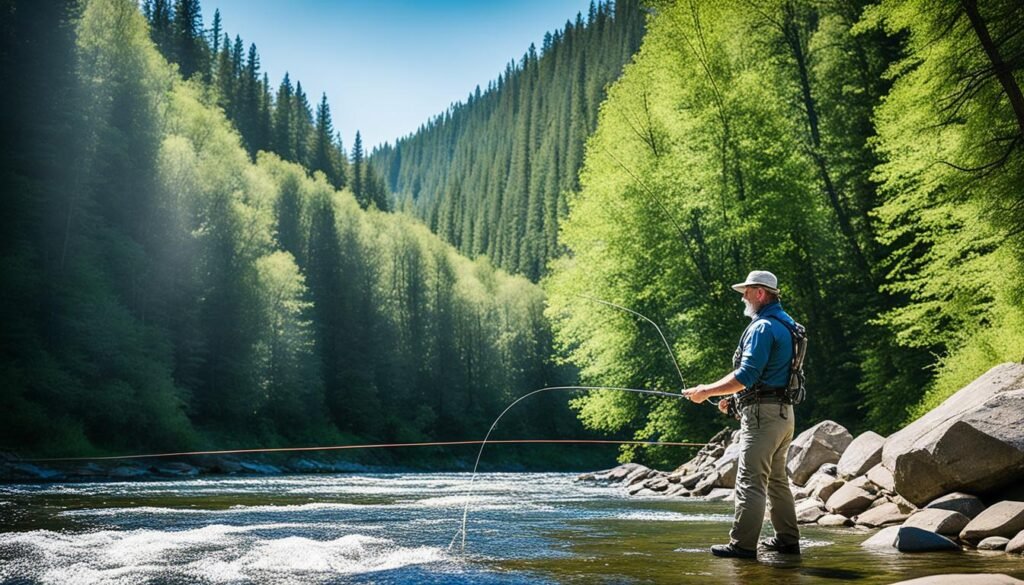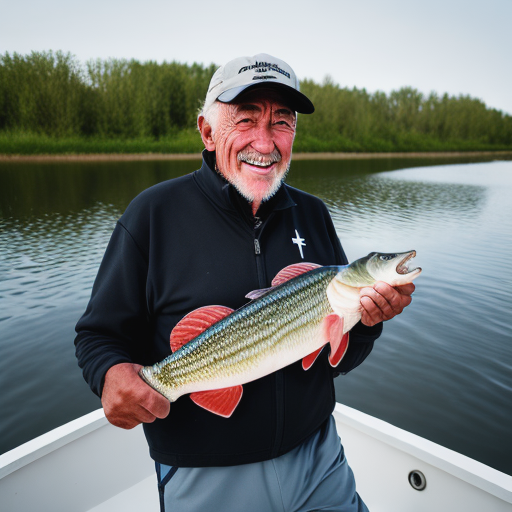Fly casting is like an art for anglers. It can greatly affect how successful you are in fishing. Whether you’re new to fishing or very experienced, learning fly casting is key. It helps you become more accurate, precise, and improves your fishing adventure. Better skills mean you can get your fly right where the fish are.
This article will explore fly casting techniques in detail. You’ll gain the knowledge and skills to up your fishing game. We’ll cover the different casts, the importance of timing and rhythm, and everything you need to cast like a pro.
Key Takeaways:
- Mastering fly casting techniques improves accuracy and precision
- Understanding the different types of casts enables adaptability to different fishing situations
- Timing and rhythm are crucial for a smooth and efficient casting motion
- Adapting to different weather and water conditions is essential for successful fly casting
- Choosing the right tools and equipment enhances your casting performance
The Importance of Mastering Fly Casting Techniques
Learning fly casting techniques is crucial for anglers wanting to boost their skills and fun while fishing. These skills help anglers cast their fly more accurately, making the lure look natural on the water.
Fly casting allows anglers to put their fly gently on the water. This mimics insects and lures fish to bite. A good cast can draw a fish’s attention or scare it away.
Mastering these techniques also makes fishing more versatile and adaptable. Sometimes you need to cast far, while other times, it’s about precise casts in small areas. Being able to change your technique for various situations helps catch the fish you want.
Better fly casting means you spend more time fishing and less time casting. This makes you better at catching fish. Efficient and accurate casts let your fly stay in the water longer, tempting more fish.

Investing in learning fly casting can really improve your fishing game. Better accuracy and versatility mean more fun and success. We will look at various fly casts, timing, adapting to conditions, tools, and practice tips next.
Understanding the Types of Fly Casts
Anglers need to know several fly casts. Each one is for different situations when fishing. Here are some key types:
1. Overhead Cast
The overhead cast is key for placing your fly accurately on the water. It’s smooth and helps attract fish where you aim your fly. This cast is about making a controlled and precise presentation.
2. False Cast
The false cast is different – it’s not about landing your fly. Anglers use it to dry a fly, extend line, or change its direction. It lets anglers be flexible during fishing.
3. Roll Cast
Roll casts are for tight spots or when you can’t do a backcast. By creating a loop of line behind, the line rolls out the fly. This technique is perfect for fishing in narrow areas.
4. Tuck Cast
The tuck cast is great for nymphing or using heavy flies. It places your fly gently in the water with hardly any splash. It makes the fly act like a real insect, attracting fish.
Now you know about these fly casting methods. It’s vital to keep practicing to improve. Try each of these casts to gain skill and handle different fishing settings.
Fly casting is a mix of skill and knowledge. The more you practice, the better you’ll get. So, keep trying new casts and have fun exploring the world of fly fishing!

Mastering the Timing and Rhythm
Timing and rhythm are key in fly casting. They help improve how you cast. You can cast further and more precisely this way. The “ten-to-two” rule is a big help. It says to stop your cast at ten o’clock on the back and two o’clock on the front. This keeps your line in check and helps avoid messy casts.
Getting the feel for timing and rhythm takes practice. A good trick is to have a beat in your head while you cast. This makes your casts smooth and on point. It builds a memory in your muscles too. That’s why the rhythmical approach is so helpful.
Timing and rhythm matter a lot, but personal style is key too. As you get better, you might change the rules a bit. This is to match how you naturally cast. Practice helps you understand what works best for you.
Focusing on timing and rhythm as you practice will make you a better caster. Your casts will be more accurate and smooth. This leads to better fishing trips every time.

Quotes:
“Timing and rhythm are the heartbeat of fly casting.” – David Lambert, Fly Fishing Enthusiast
Fly Rod Casting Tips:
- Practice the “ten-to-two” rule for maintaining proper line control.
- Count in your head or practice with a steady beat to develop timing and rhythm.
- Experiment with variations within the guidelines to match your casting style.
Adapting to Different Weather and Water Conditions
Weather and water impact fly casting a lot. Changing your casting to fit these conditions is key. We will see how anglers can get better at fly casting by changing their techniques based on the weather and water.
Casting Against the Wind
Windy weather makes fly casting hard. But, you can beat the wind. When casting into the wind, aim your fly lower and make a tight loop. This keeps your cast more accurate, fighting the wind’s effect.
Adjusting for Different Water Conditions
Each water type needs a special cast method. In calm lakes or still water, cast smoothly and gently. This makes it less likely to scare fish away. For rivers with strong currents, use a stronger cast to get to your target.
Practicing in Diverse Conditions
Anglers should practice in all types of weather and water. This lets them adapt to any situation. By facing wind, calm, fast-flowing or still waters, you get better at fly casting. Practice makes you skilled in different fishing setups.

| Weather Conditions | Casting Technique |
|---|---|
| Windy | Aim lower and use a tighter loop |
| Calm | Focus on smooth and delicate presentations |
| Fast-flowing rivers | Utilize stronger and more powerful casts |
Tools and Equipment for Effective Fly Casting
Choosing the right tools and equipment is key for fly casting success. The right gear makes your casting better and raises your chances of catching fish. Let’s look at some important items you should have:
Fly Rods
Fly rods come in different weights for specific fishing needs. For starters, a medium-action rod is great. It helps learn basic casting well. This type of rod gives you a good mix of flexibility and power. This makes controlling your casts easier. Pick a rod weight that matches the fish size you’re aiming for.
Fly Lines
The type of fly line is crucial for good casting. For newbies, a weight-forward line is a good choice. It helps with control and allows for longer casts. These lines are thicker at the front, aiding in accuracy and cast control.
Flies
Having diverse flies is vital. Different fish like different fly types. Make sure your tackle box has many options. Also, know the local insects to pick the right flies. From dry flies to streamers, a variety ensures you’re ready for any fishing.
Other Accessories
There are also accessories that can make fly casting better:
- Fly Reels: A good balance with your rod and a smooth drag is important.
- Leaders and Tippets: These clear lines make your fly look natural to fish.
- Waders and Boots: Necessary for fishing in water to stay dry and comfortable.
- Fly Boxes: Keep flies organized for quick access with a quality fly box.
- Nippers and Pliers: Handy for cutting line, adjusting knots, and handling fish.

Getting top-quality tools and equipment will improve your fly casting. Pick gear that fits your style and the conditions of where you’ll fish. For both new and experienced fishermen, the right gear is crucial for success.
| Item | Description |
|---|---|
| Fly Rod | Medium-action rod matched to target fish |
| Fly Line | Weight-forward line for better control and longer casts |
| Flies | Diverse selection to match local insect hatches |
| Fly Reel | Smooth drag system, balanced with rod |
| Leaders and Tippets | Transparent lines for subtle presentation |
| Waders and Boots | Essential for staying dry in rivers or streams |
| Fly Boxes | Organize and store flies for easy access |
| Nippers and Pliers | Tools for line trimming, knot adjustment, and fish handling |
Practice Tips for Fly Casting
Improving your fly casting skills takes practice. Anglers can better their technique and enjoy fly fishing more. Here are some top tips to enhance your casting:
- Identify specific casting needs: Think about what you’ll need to do before you go fishing. Work on casting far in the wind or gently laying out small flies. Customize your practice sessions for this.
- Simulate real fishing situations: Try to mimic real fishing scenarios when you practice. Use the same equipment you’ll use on your trip. This helps build muscle memory and get familiar with your gear.
- Focus on fly presentation: How you present your fly is key in fly fishing. Work on placing your fly exactly where you want it. Make it look like a real insect on the water.
- Mark the fly line: Using markers on your fly line can help you with casting distances. This makes it easier to see how far you’re casting accurately.
- Consistency in leader construction: Keep your leader setup consistent while practicing. This makes your casting in real fishing situations match your practice. Your leader is what connects your line to your fly.
Following these tips can enhance your fly casting. With consistent practice, you’ll fish more successfully. Remember, practice is the key to perfecting your skills. So, put in the time and effort to fine-tune your casting.

Five Essential Casting Techniques for Anglers
For fly fishing success, it’s key to master various casting techniques. Each serves a special purpose, improving your fly’s presentation. Here are five must-know casting techniques for all anglers:
1. Roll Cast
The roll cast is vital for casting in tight spots, like where trees block the backcast. It uses the water’s tension to send your line forward. This is perfect for small streams or when space is tight.
2. Bow and Arrow Cast
This technique helps you cast precisely in tough spots. You hold the line ready, then let it go, just like an arrow launch. It’s great for getting around obstacles or aiming in small areas.
3. Double Haul Cast
The double haul cast enhances your power to throw bigger flies farther. By pulling on the line both ways, you shoot the fly further and faster. It takes some practice, but it really boosts your casting game.
4. Steeple Cast
For tight creeks with heavy vegetation, the steeple cast is the way to go. You aim almost straight up, then let the line gently fall. This prevents snags and helps for accurate shots in tough conditions.
5. Tuck Cast
The tuck cast is crucial for nymph fishing. After you cast, you flick the line forward to sink the fly fast. It’s a great method for deep water or fast streams.
Learning these techniques makes you a better angler. With practice, you’ll handle various fishing spots and conditions better. Always choose the right technique to present your fly well and catch more fish.

Conclusion
Fly casting is a key skill for anyone who loves fly fishing. By learning various casts and getting the right timing, you can fish more accurately. This means you’re more likely to catch fish.
Anglers should also be ready for different weather and water conditions. Using the best tools is crucial too. All these things make fly casting better.
Dedication makes a big difference. With enough practice, you’ll get better at all types of casts. This means you’ll do well even in tough fishing spots or when you need to sink flies fast.
For both new and old anglers, learning these skills will make fishing more enjoyable. Always remember, getting good at this takes practice. And by working on your skills, you’ll have a lot more fun fly fishing.
FAQ
Why is mastering fly casting techniques important for anglers?
Learning fly casting adds to accuracy and presentation. It also boosts anglers’ flexibility across fishing settings. Plus, it makes fishing more effective and enjoyable.
What are the different types of fly casts that anglers should know?
Anglers need to learn several key casts. These include the overhead, false, roll, and tuck casts.
How can anglers improve the timing and rhythm of their fly casting?
To get better timing and rhythm, follow the “ten-to-two” rule. Try practicing to a steady beat or by counting. This can be a big help.
How should anglers adapt their fly casting to different weather and water conditions?
Anglers must adjust for changing weather and waters. For instance, cast differently when it’s windy. Also, think about the water speed, like in a lake versus a river.
What tools and equipment are essential for effective fly casting?
The right tools are crucial for good fly casting. Choose a fitting fly rod weight and line. Also, have a variety of flies for different fishing situations.
What are some practice tips for improving fly casting?
For practice, aim for your casting needs. Use the gear you’ll fish with. Mark your fly line for distance. Lastly, pay attention to your fly presentation.
What are the five essential casting techniques for anglers?
Know these essential casts: roll cast, bow and arrow cast, double haul cast, steeple cast, and tuck cast.
Why should anglers master fly casting techniques?
It’s key for better accuracy, versatility, and efficiency in fly fishing. This mastery boosts fishing experiences all around.

